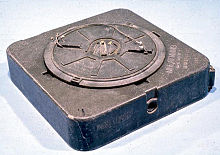
Valmara 69 or V-69 is an Italian bounding anti-personnel mine manufactured by Valsella. The mine was developed from the V-59 mine, and although the mine is no longer produced in Italy, a number of copies were produced in other countries e.g. the "SPM-1" manufactured by Singapore.

The Tellermine 35 (T.Mi.35) was a German metal-cased anti-tank mine used extensively during the Second World War. The mine's case is made of sheet steel, and has a slightly convex pressure plate on the top surface with a central fuze well. Two secondary fuze wells are located on the side and bottom of the mine for anti-handling devices.

The MON-90 is a Claymore-shaped, plastic bodied, directional type of anti-personnel mine designed in the Soviet Union. It is designed to wound or kill by fragmentation. The mine is similar in appearance to the MON-50, but is approximately twice the size with a much greater depth.

The Tellermine 42 (T.Mi.42) was a German metal-cased anti-tank blast mine used during the Second World War. The mine was a development of the Tellermine 35 with improved resistance to blast. It was followed by the simplified Tellermine 43. The Tellermine consists of a circular pressed steel main body with a large central pressure plate. The pressure plate is smaller than the earlier Tellermine 35, which increases the mine's resistance to blast. Two secondary fuze wells are provided for anti-handling devices, one in the side, and one on the bottom of the mine. The mine has a carrying handle.

The Tellermine 43 was a German circular steel cased anti-tank blast mine used during the Second World War. It was a simplified version of the Tellermine 42, which enabled simpler production techniques. Between March 1943 and the end of World War II, over 3.6 million Tellermine 43s were produced by Germany. Copies of the mine were produced by several countries including Denmark (M/47), France and Yugoslavia (TMM-1).
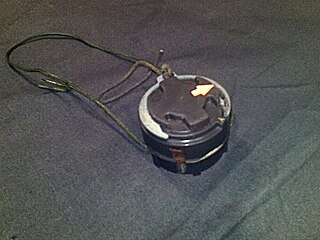
The M14 mine "Toepopper" is a small anti-personnel land mine first deployed by the United States circa 1955. The M14 mechanism uses a belleville spring to flip a firing pin downwards into a stab detonator when pressure is applied. Once deployed, the M14 is very difficult to detect because it is a minimum metal mine, i.e. most of its components are plastic. Because of this, the design was later modified to ease mine clearance with the addition of a steel washer, glued onto the base of the mine.
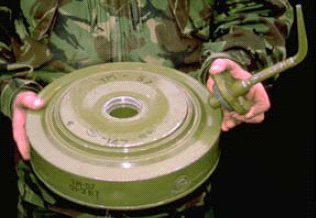
The TM-57 mine is a large, circular Soviet metal-cased blast anti-tank mine. It can either be triggered by a pressure or a tilt-rod fuze. A development of the TM-46 mine, it is found in Africa, the Middle East, and South East Asia.

The TM-46 mine is a large, circular, metal-cased Soviet anti-tank mine. It uses either a pressure or tilt-rod fuze, which is screwed into the top. Anti-tank mines with this type of fuze were capable of inflicting much more damage to armored vehicles, when compared to a typical anti-personnel mine.

The PMN series of blast anti-personnel mines were designed and manufactured in the Soviet Union. They are one of the most widely used and commonly found devices during demining operations. They are sometimes nicknamed "black widow" because of their dark casings.

The VS-MK-2 is a plastic bodied scatterable anti-personnel blast mine manufactured by the now-defunct Valsella Meccanotecnica, SpA, an Italian high-tech defence contractor that specialized in the development and production of area denial systems. The mine is extremely difficult to detect because of its low metal content i.e. it is a minimum metal mine. Additionally, it is resistant to blast overpressure due to a pneumatic system in the fuze. The mine will also function in up to 1 metre of water. An electrically fused anti-handling version of the mine was also produced designated VS-MK-2-EL, VS-MK-2-E or VS-MK2 AR-AN to hinder clearance attempts. Although Italy has ceased production of this mine it may still be found in uncleared minefields located in Angola, Sudan and the Western Sahara.

The M15 mine is a large circular United States anti-tank blast mine, first deployed during the Korean War. Essentially, it is a larger version of the M6A2 anti-tank mine, which it replaced. Although the M15 has been superseded by the M19 mine, the U.S. retains large stocks of M15s because they are still regarded as reliable and effective weapons. When used against main battle tanks the M15 is primarily a "track-breaker" which creates mobility kills, but has a comparatively small likelihood of causing crew fatalities. However, when used against light vehicles such as APCs or unarmored vehicles such as trucks the damage it can inflict is much more severe.
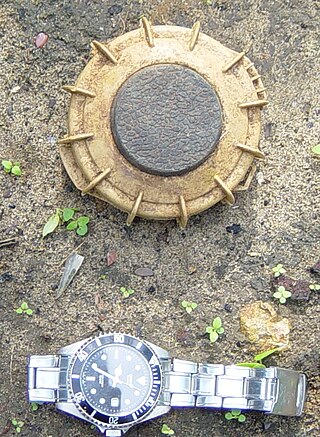
The VS-50 is a circular plastic-cased anti-personnel blast mine that entered production in 1985. It was formerly made by the now-defunct Valsella Meccanotecnica SpA, an Italian high-tech defence company specialized in area denial systems. The company also the made the Valmara 69, and was one of the first to implement plastic construction for landmines. The VS-50's design is similar to that of the TS-50 and VS-MK2 mines. It is blast resistant and can be used in a minimum metal configuration. Though unlikely to kill, its explosive charge is quite sufficient to destroy the victim's foot, being capable of penetrating 5 mm of mild steel leaving an 80 mm-diameter hole.
The M7 is a small, metal-cased United States anti-tank blast mine that was used during the Second World War. It was based on the British Hawkins grenade. Approximately 2.5 million were produced before production ceased, and although it has long since been withdrawn from U.S. service, it can be found in Angola, Burma, Cambodia, Chad, Eritrea, Ethiopia, Korea, Lebanon, Myanmar, Somalia, Thailand, and Zambia.

The M1, M1A1 and M4 are circular steel cased United States anti-tank blast mines with a distinctive cross shaped pressure spider. The mine was used during the Second World War and a copy produced in Argentina was used during the Falklands War. Another copy is produced in China, there designated as the No. 4 mine. Variants of the mine have also been deployed in Chad and Tunisia.
The M6, M6A1 and M6A2 are a series of metal-cased, circular, heavy anti-tank landmines produced by the United States from May 1944 to May 1945.

The TMA-1 and TMA-1A are circular, plastic cased Yugoslavian minimum metal anti-tank blast mine. The mine consists of an upper plastic pressure plate, and the lower body containing the main charge. The pressure plate has eight triangular raised sectors, and a central fuze cap. The pressure plate is held in place by four plastic pins, which when sufficient pressure is applied, shear allowing the pressure plate to collapse onto the mine body, triggering the UANU-1 fuze. A secondary fuze well is provided in the base of the mine, allowing the use of anti-handling devices. The mine is found in Bosnia, Croatia and Kosovo.
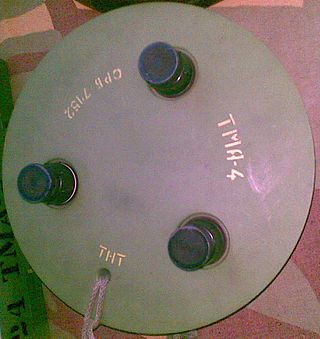
The TMA-4 is a circular plastic cased Yugoslavian minimum metal anti-tank blast mine. It is a modernized version of the TMA-3. The mine is basically a cast block of TNT with three fuze wells cut into it, encased in plastic. Three black plastic UTMA-4 fuzes are installed into the top surface of the mine. A thin rope carry handle is also provided. The small pressure plate area of the fuzes make the mine resistant to overpressure from explosive demining techniques. Additionally the low metal content of the mine make it very difficult to detect. Although no secondary fuze well is provided, it is possible that the mine could be fitted with improvised anti-handling devices.

A minimum metal mine is a land mine that is designed to use the smallest amount of metal possible in its construction. Typically, the only metal components are located inside the fuze mechanism which triggers detonation. Both minimum metal anti-tank and anti-personnel mines exist. Some designs contain virtually no metal at all, e.g., less than a gram. This is achieved by encasing the explosive charge in a plastic, wooden, or glass body, with metallic components limited to the few small parts in the fuze which can not easily be made from other materials, such as the spring, striker tip, and shear pin. Minimum metal mines are extremely difficult to detect using conventional metal mine detectors and usually require modern techniques, such as robotic Multi Period Sensing (MPS) equipment, to identify, but it is still extremely difficult to find non-metallic mines. These techniques are usually restricted to well-funded international mine clearing organizations and major militaries, making minimum metal mines especially pernicious where they are encountered.
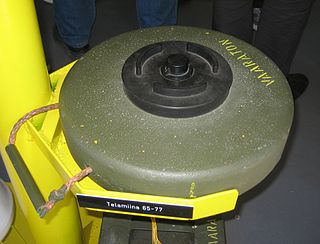
The TM 65 is a circular Finnish minimum metal anti-tank blast mine. It is broadly based on the Russian TM-62 mine. The mines body is made from a thin shell of fibreglass over a cast block of explosive, with a central fuze well that holds the pressure fuze. The original TM 65 used a US-65 fuze as used in the SM-65 anti-personnel mine, the later TM 65 77 uses a pressure fuze similar to the Russian MV-5 fuze called Painesytytin 77.

An anti-handling device is an attachment to or an integral part of a landmine or other munition such as some fuze types found in general-purpose air-dropped bombs, cluster bombs and sea mines. It is designed to prevent tampering or disabling, or to target bomb disposal personnel. When the protected device is disturbed, it detonates, killing or injuring anyone within the blast area. There is a strong functional overlap of booby traps and anti-handling devices.
